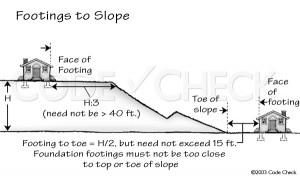Basements and crawl spaces with sump baskets may or may not be drain tiled. And drain tiles can be located on either the interior or the exterior of the foundation footing. Contractors will give varying opinions on which method is best, but it really doesn’t matter. In real swampy locations, ‘cautious’ contractors will install drainage tiles on both sides of the foundation. Home inspectors in Minneapolis and St. Paul pay very close attention to the existence and quality of installation of these sumps in order to protect their clients from future water damage and mold problems.

Next, what about big hills? Historically, home buyers and Realtors have been very skittish about homes that back up to large hills. The obvious concern is the large volume of water running directly towards the house. Frankly, many people walk away from purchasing a perfectly good home just because of this topography. Steep hills in building code terms are those that have a 45 degree slope or greater. The question is should we be apprehensive about this. The answer is no…just as long as the correct detail to earth slope, drainage swales, and possibly retaining walls are observed.
So, if we obey the principles of controlling surface and subsurface water, we should be able to buy or sell a home, with confidence, in almost any location and keep the water out of the basement. As a MN home inspector for the past 25 years, it’s amazing to me that so many homeowners don’t do this. They sure would sleep better on those dark rainy nights if they did.
Did you know small moisture intrusion problems in basements are a much greater mold concern than a major flood…WHY?
Doug Hastings
Home Inspector Minnesota
Kaplan Instructor


